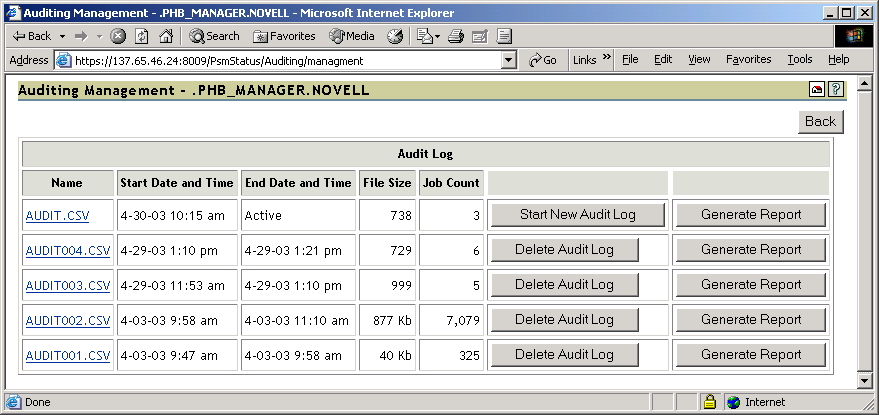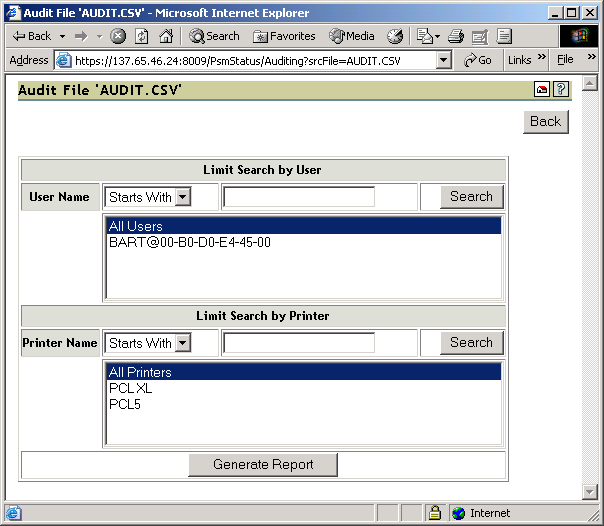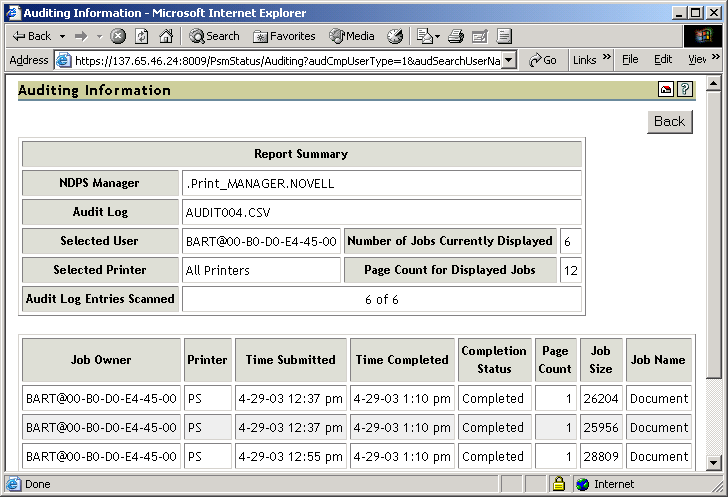4.6 Using Print Auditing
When auditing is enabled for a Printer Agent, a log file is created indicating who printed how many pages to which printer on a given date. The log file is in a comma-separated format (.csv). The data from this log file can be viewed from the Health Monitor or downloaded into a spreadsheet.
Figure 4-1 Auditing Page

From the Internal Auditing page you can complete the following tasks:
4.6.1 Enabling Auditing
You can use either Novell iManager or the NDPS Manager Health Monitor to enable auditing.
Using Novell iManager to Enable Auditing
You need to enable auditing for each printer you want to audit.
-
In Novell iManager, click > .
-
Select the printers you want to enable auditing for by clicking the check box in the column. Click the check box at the top of the column to enable auditing for all printers in the list.
Using the Health Monitor to Enable Auditing
You need to enable auditing for each printer you want to audit.
-
On the NDPS Manager Health Monitor main page, click the printer you want to enable auditing for.
-
Click .
-
Click the check box.
4.6.2 Viewing Auditing Information
You can generate an audit report that shows all print jobs or you can filter the report based on a user or a printer or both.
-
In Novell Remote Manager, click > > .
-
Click .
If there is more than one audit log, click for the audit log you want to view.
-
(Optional) Filter the search by using the and filters.

-
Click to view the report.
Only 250 print jobs are listed at a time. To view more print jobs in the report, click .

The following table describes what is displayed in the report.
Table 4-1 Report Summary Information
The following table describes what is displayed in the body of the report.
Table 4-2 Report Fields
4.6.3 Managing Audit Logs
You can manage your audit logs by using the displayed buttons on the Auditing Management page. When audit logs are no longer needed, you can manually delete them. To automatically save and create new logs, see Section 4.6.4, Configuring Automatic Log Rotation.
The active audit log file (audit.csv) logs data for all printers that have been enabled for auditing. You can generate a report from this file or you can move the data to a saved file using . You cannot download the audit.csv file. To download a file, it must be saved as a separate audit log. When you move the data to a saved audit log using the button, the log file is named auditxxx.csv, where xxx is the next sequential number of the log. After a log file is saved, you can download the file to your workstation and import it into a spreadsheet program.
4.6.4 Configuring Automatic Log Rotation
Audit Log Rotation automatically creates a new log when certain criteria is met.
-
In the Print Manager Health Monitor, click > > .
-
Select .
-
Enter the number of logs to keep.
When the number of logs to keep is reached, the oldest log is deleted when the next log is created. When setting this number, take in to account the criteria you are using to create a new log file. If you want a years worth of logs, set the number of audit logs to keep to 12 and the select the and options.
-
Choose the criteria used for log rotation:
By Job Count: Enter the maximum number of print jobs that a audit log can contain before a new log is created.
By Date: Select when you want the audit logs to rotate.
-
Day: The log rotates each day at midnight.
-
Week: The log rotates each Sunday. If the Print Manager is not loaded on Sunday, the log is rotated the next time the Print Manager starts.
-
Month: The log rotates at midnight on the first day of the month.
NOTE:If you select or , ensure that the entry is large enough so that logs are not rotated before you need the data.
By File Size: Specify the maximum file size in kilobytes before a new log is created. The maximum file size is 4 gigabytes.
-
4.6.5 Downloading an Audit Report
-
On the NDPS Manager Health Monitor main page, click > .
-
Right-click the name of the audit log you want to download, then click .
-
Follow the prompts and save the file to your desired location.
When the file is downloaded, you can open the report in a spreadsheet application to sort, view, and format the data to meet your needs.